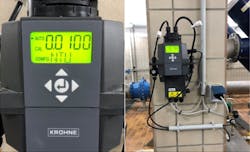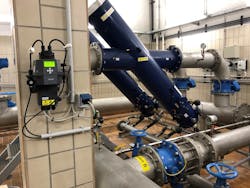Online measurement of turbidity in a drinking water distribution station
Background
As a multi-utility provider, Linz AG is responsible for energy supply, public transport, and municipal services for the city of Linz, Austria and other municipalities in the state of Upper Austria. including the supply of drinking water in the region.
Measurement requirements
Linz AG operates several drinking water distribution stations. Monitoring of the drinking water’s quality parameters is done at those stations before distribution to households and industrial consumers. One of the most important water supply field parameters is turbidity since drinking water should always be clear and free of undissolved substances. If the turbidity changes abruptly, this may indicate mineral, organic, or biological contamination. Evidence of turbidity monitoring must be available for the water authority.
Process parameters
- Medium water
- Turbidity <0.2 NTU
- Operating density 997 kg/m3
- Pressure 17.4 psi
- Temperature +50…53.6°F
- iscosities 1.297 mPas
The stringent standards for drinking water are also reflected in the limit values set for the distribution facility. A warning is triggered at a value of 0.1 NTU. If a value of 0.2 NTU is exceeded, then an alarm is activated. This application requires a continuous dynamic measurement that responds quickly to changing drinking water turbidity and the previous instrumentation had to be upgraded in three distribution stations.
KROHNE’s solution
After a detailed selection process, the OPTISYS TUR 1060 turbidity measurement system impressed the customer both in terms of performance and measuring dynamics as well as the initial acquisition and on-going operating costs. The OPTISYS TUR 1060 was integrated into the process via a bypass line and the optimized cuvette measuring design allows it to detect changes in turbidity very quickly for this application’s lower turbidity measuring range.
The measuring system determines the turbidity by scattered light measurement (nephelometry). The light scattering of a formazine suspension with a known concentration is compared with the light scattering in the drawn water sample at a 90° angle to the irradiated light (90° infrared scattered light according to ISO 7027). Little maintenance is needed since the system features automated ultrasonic cleaning and the measuring optics are not directly exposed to the sample.
An analog 4 to 20 mA output signal is transmitted to the control room along with relay outputs for limit value monitoring and alarming. A trend recording is captured and available to the customer via a USB port.
Customer benefits
With the OPTISYS TUR 1060, the customer can consistently monitor and detect drinking water turbidity. The very quick response time of the system ensures that the water purveyor can react immediately when turbidity increases. If defined limit values are exceeded, the measuring system triggers a warning or alarm in the control room. In this way, the customer always succeeds in complying with its strict quality management to ensure that the turbidity does not exceed a value of 0.2 NTU. Thus, a high level of drinking water safety is guaranteed.
The OPTISYS TUR 1060 impressed the customer with its attractive price-performance ratio and its low operating costs also offered a clear long-term advantage. The design and the integrated ultrasonic cleaning minimize deposits and simplifies the maintenance effort significantly. The KROHNE system also has an integrated shut-off valve for calibration and to check the cuvette quickly and easily as necessary. This saves a great deal of effort during maintenance. KROHNE also can provide certified test kits for cuvette calibration.

